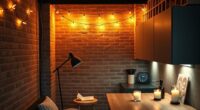To backlight your TV without glare, position your lights behind the screen in a way that avoids direct reflections. Use soft, dimmable LED strip lights or diffuse ambient lighting to create a gentle glow that enhances contrast without overpowering the picture. Adjust the angle of your lights to prevent glare and keep ambient lighting at a comfortable level. If you want detailed tips to perfect your setup, keep exploring how to achieve an ideal viewing environment.
Key Takeaways
- Place LED strip lights behind the TV to create a soft, diffuse glow that enhances contrast without causing glare.
- Use dimmable, indirect lighting fixtures positioned to avoid facing or reflecting directly on the screen.
- Adjust the angle of ambient lights to prevent direct reflections and screen glare.
- Keep ambient room lighting at a moderate level with neutral or cool tones to reduce eye strain and glare.
- Ensure the backlighting is balanced with ambient light for comfortable viewing and minimal reflections.

If you’ve ever struggled with glare on your TV screen, backlighting can be be a game-changer. It helps create a more comfortable viewing experience by reducing eye strain and improving picture quality. But to truly benefit, you need to pay attention to ambient lighting and how it interacts with your screen reflection. Proper backlighting doesn’t just mean adding lights behind your TV; it’s about creating a balanced environment that minimizes glare and enhances contrast.
Ambient lighting plays an essential role in preventing screen reflection, which is often the culprit behind unwanted glare. When the room is too brightly lit or has harsh, direct light sources, your eyes tend to focus on the reflections bouncing off the screen surface. This makes it difficult to see details clearly and can cause discomfort during long viewing sessions. To avoid this, opt for soft, diffuse ambient lighting that evenly illuminates the room without shining directly onto the screen. LED strip lights placed behind the TV, for example, can cast a gentle glow that adds depth to the picture without creating additional glare.
Soft, diffuse ambient lighting reduces glare and enhances picture depth without harsh reflections.
Additionally, consider the placement of lights in relation to your TV. Position lamps and fixtures so they don’t face the screen directly, and try to keep light sources at a lower intensity. If you notice reflections or glare, adjusting the angle of your lights or using dimmable fixtures can make a significant difference. Using matte or anti-reflective screen coatings can further reduce the impact of ambient light and screen reflection, helping you enjoy your favorite shows without distraction.
Furthermore, choosing the appropriate ambient lighting can help balance the overall luminance, reducing the likelihood of eye fatigue and improving the viewing experience over time.
When setting up backlighting, aim for a subtle glow that enhances the picture without overpowering it. The goal is to create a visual balance where the ambient lighting complements your TV’s backlighting, leading to a more immersive experience. Avoid overly bright or colorful lighting that can compete with the content on screen and cause eye fatigue over time. Instead, opt for neutral or cool tones that provide a calming environment, especially in darker rooms.
Ultimately, the key to backlighting your TV without glare lies in managing ambient lighting and minimizing screen reflection. By carefully choosing your lighting setup and positioning, you’ll reduce glare, improve contrast, and enjoy a clearer, more comfortable viewing experience. The right combination of ambient light and backlighting ensures that your screen remains the focal point, free from distracting reflections and harsh glare.
Frequently Asked Questions
Can Backlighting Damage My TV Over Time?
Backlighting your TV won’t damage it if you carefully manage LED placement and brightness adjustment. If the LEDs are too close or too bright, they could cause heat buildup or uneven backlight, potentially harming the screen over time. To prevent this, make sure LEDs are positioned correctly, use dimmable lights, and keep brightness at a comfortable level. Properly managed, backlighting enhances your viewing experience without risking your TV’s longevity.
What Is the Best Color for Backlighting to Reduce Glare?
You’ll want to choose a soft, warm color for your backlighting, like amber or warm white, to gently complement ambient light and minimize glare. Cooler colors, such as blue or icy white, can create stark contrast and increase eye strain. By selecting a hue that blends smoothly with your room’s lighting, you enhance overall comfort and reduce distractions, ensuring a cozy viewing experience without harsh reflections or glare.
How Does Backlighting Affect TV Picture Quality?
Backlighting improves your TV picture quality by enhancing contrast and reducing eye strain. It creates a balanced ambient lighting environment that prevents glare and makes darker scenes more detailed. When you add subtle backlighting, you’ll notice better color accuracy and deeper blacks, giving you an immersive viewing experience. Proper contrast enhancement from backlighting guarantees images look vivid without washing out, making your TV viewing more comfortable and visually appealing.
Can Backlighting Be Installed on Any TV Size?
Yes, you can install backlighting on any TV size. You just need to take into account suitable mounting options that fit your TV’s dimensions and make certain you have appropriate power sources nearby. Larger TVs might require longer LED strips or multiple sections, while smaller screens need less. Always check compatibility and installation instructions to make sure the backlighting system works seamlessly with your TV, regardless of its size.
Is Wireless Backlighting More Effective Than Wired?
Sure, wireless backlighting beats wired setups every time—unless you love wiring complexity and endless cable spaghetti. With wireless convenience, you just plug in and go, no fuss or tripping hazards. Wired systems may offer slightly more stability, but who wants to deal with tangled messes? For simplicity and sleek aesthetics, wireless backlighting is the clear winner, making your TV setup look modern and clutter-free—no extra cords required.
Conclusion
By carefully setting up backlighting, you can enjoy a cozy, glare-free viewing experience that feels like watching a movie in a private theater. Think of it as painting a calm sunset behind your TV—enhancing colors without overwhelming your eyes. Just remember to position the lights correctly and choose the right brightness. With a little effort, you’ll create an inviting atmosphere where your screen shines softly, making every movie night truly relaxing.









